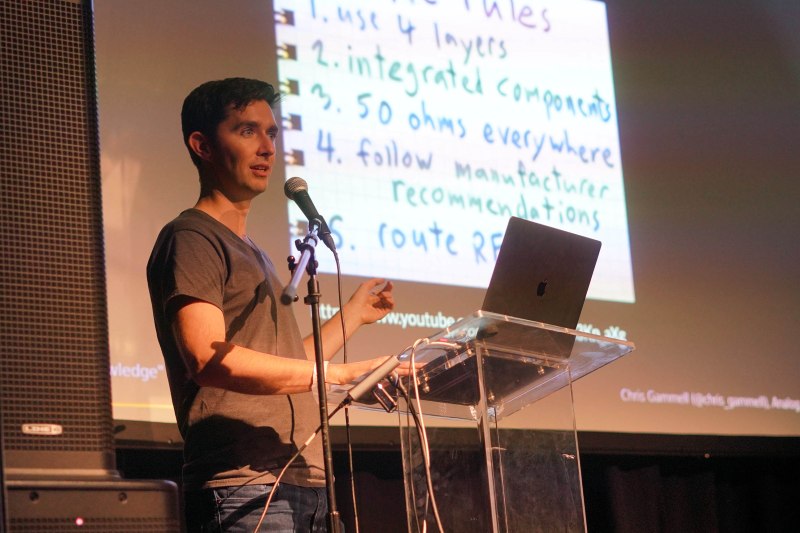Those of us who work with electronics will usually come to the art through a particular avenue that we master while imbibing what we need from those around it. For example, an interest in audio circuitry may branch into DSP and microcontrollers as projects become more complex. Some realms though retain an aura of impossibility, a reputation as a Dark Art, and chief among them for many people is radio frequency (RF). Radio circuitry is often surprisingly simple, yet that simplicity conceals a wealth of complexity because the medium does not behave in the orderly manner of a relatively static analogue voltage or a set of low-frequency logic levels.
Chris Gammell is a familiar face to many Hackaday readers for his mastery of much electronic trickery, so it comes as something of a surprise to find that RF has been one of the gaps in his knowledge. In his talk at the Hackaday Superconference he took us through his journey into RF work, and the result is a must-watch for anyone with a curiosity about radio circuitry who didn’t know where to start.
For readers whose introduction to electronics came through the medium of amateur radio, the talk will follow a familiar path as it deals at a simple level with the very fundamentals of how signals pass through circuitry at RF frequencies. We learn about matching and gain, and most importantly about losses between stages and how careful design can minimise them. He makes the point that advances in integrated circuits have put wireless capabilities within the range of almost any designer, and it’s worth observing that this along with a more relaxed approach to spectrum usage in most regions means that ever-higher frequencies have become the norm at which physical design becomes ever more critical.
The talk continues with his discoveries in test equipment, in PCB layout, and in the shortcomings of common components at higher frequencies. It’s a subject that we’ve touched on before in a report from a previous Superconference, as RF design guru Michael Ossmann gave us his tips.
If you’re an experimenter this shouldn’t be an area to be afraid of. The low cost of so many of the devices and modules involved mean that there is plenty of scope to give it a try without breaking the bank. At a simpler level some experience can also be gained with more traditional RF, try experimenting with TV antenna pre-amplifiers for example, something for the 70cm amateur band, or even messing about with scrap UHF TV tuners. There may be plenty of pitfalls for the unwary RF experimenter, but there is still plenty of scope for learning experiences.

















It would be nice to list the books, video channels, and web sites from the talk.
The slides from the talk are available here:https://chrisgammell.com/talks/gaining-rf-knowledge/
The slides don’t provide any information at all.
50 ohm transmission lines are able to handle the most RF power for a given size.
75 ohm transmission lines have the lowest signal loss for a given size.
IF you are building a receiver, or under a kilowatt transmitter, doing the “50 ohms everywhere” rule shows a lack of design knowledge. Perhaps brilliant in digital design, but stop giving out incorrect information.
If you have “design knowledge”:
a) you probably do not need to resort to 5 point rule list,
b) you know that what you stated above is true for air dielectric and modern coax cables for example have PTFE foam or solid PTFE dielectric that pushes lowest loss impedance into 64-52ohm range.
c) 50ohms more typical for UHF/VHF (antennas, coax, connectors etc).
If you don’t have “design knowledge” then “50ohms everywhere” is a good rule of thumb.
Actually the 50 Ohm figure (which only applies to coax cable) is a compromise, half-way between the ~30 Ohms where breakdown voltage of an air dielectric is highest, and ~77 Ohms, where reactive loss is less. Also, a half-wave dipole is about 75 Ohms at resonance. But you can’t just hook up a 75 Ohm coax to a dipole because coax isn’t a balanced line, so that’s moot.
75 Ohm RG59 coax has been the standard for intra-plant cabling to carry baseband video, sync and related non-video signals for as long as I can recall. A good (analog) studio camera could put out a baseband video bandwidth of as much as 10 MHz. That gets chopped down to ~4.2 MHz for broadcast, but we’d always want the flattest, most extended frequency response before then. Digital SDI cable is also 75 Ohm. When TV production facilities went digital, the existing RG59 could be used for SD and some HD signals, though upgrading to RG6 or better is needed for 3G-SDI or better.
Before cable TV, most OTA antenna leads were 300 Ohm twin lead balanced cable. When installed properly and kept clear of snow, twin lead provided the least loss, especially in the tricky UHF frequencies. But because it takes skill to install and maintain, most TV sets now use 75 Ohm coax only. Before hybrid fiber/coax cable, the trunk lines of a cable plant were rigid air dielectric carrying low RF power, and 75 Ohms was ideal for that too. Now it’s standard.
50 Ohms for consumer electronics like CB radios (even old 10-Base2 Ethernet) was probably picked by committee. Ham radio operators who can run much higher power levels will often run balanced line of various types and impedances between their rigs and antennas, so there’s no hard and fast “50 Ohm” rule there.